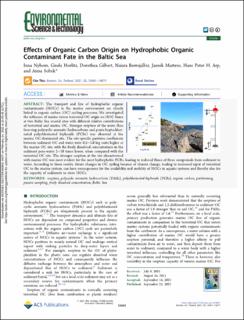| dc.contributor.author | Nybom, Inna | |
| dc.contributor.author | Horlitz, Gisela | |
| dc.contributor.author | Gilbert, Dorothea | |
| dc.contributor.author | Berrojalbiz, Naiara | |
| dc.contributor.author | Martens, Jannik | |
| dc.contributor.author | Arp, Hans Peter | |
| dc.contributor.author | Sobek, Anna | |
| dc.date.accessioned | 2022-03-04T09:16:07Z | |
| dc.date.available | 2022-03-04T09:16:07Z | |
| dc.date.created | 2021-10-22T21:20:58Z | |
| dc.date.issued | 2021 | |
| dc.identifier.citation | Environmental Science and Technology. 2021, 1-11. | en_US |
| dc.identifier.issn | 0013-936X | |
| dc.identifier.uri | https://hdl.handle.net/11250/2983023 | |
| dc.description.abstract | The transport and fate of hydrophobic organic contaminants (HOCs) in the marine environment are closely linked to organic carbon (OC) cycling processes. We investigated the influence of marine versus terrestrial OC origin on HOC fluxes at two Baltic Sea coastal sites with different relative contributions of terrestrial and marine OC. Stronger sorption of the more than four-ring polycyclic aromatic hydrocarbons and penta-heptachlorinated polychlorinated biphenyls (PCBs) was observed at the marine OC-dominated site. The site-specific partition coefficients between sediment OC and water were 0.2–1.0 log units higher at the marine OC site, with the freely dissolved concentrations in the sediment pore-water 2–10 times lower, when compared with the terrestrial OC site. The stronger sorption at the site characterized with marine OC was most evident for the most hydrophobic PCBs, leading to reduced fluxes of these compounds from sediment to water. According to these results, future changes in OC cycling because of climate change, leading to increased input of terrestrial OC to the marine system, can have consequences for the availability and mobility of HOCs in aquatic systems and thereby also for the capacity of sediments to store HOCs. | en_US |
| dc.language.iso | eng | en_US |
| dc.publisher | American Chemical Society | en_US |
| dc.rights | Navngivelse 4.0 Internasjonal | * |
| dc.rights.uri | http://creativecommons.org/licenses/by/4.0/deed.no | * |
| dc.title | Effects of Organic Carbon Origin on Hydrophobic Organic Contaminant Fate in the Baltic Sea | en_US |
| dc.type | Peer reviewed | en_US |
| dc.type | Journal article | en_US |
| dc.description.version | publishedVersion | en_US |
| dc.source.pagenumber | 1-11 | en_US |
| dc.source.journal | Environmental Science and Technology | en_US |
| dc.identifier.doi | 10.1021/acs.est.1c04601 | |
| dc.identifier.cristin | 1947920 | |
| dc.relation.project | Norges forskningsråd: 231736 | en_US |
| cristin.ispublished | true | |
| cristin.fulltext | original | |
| cristin.qualitycode | 2 | |

